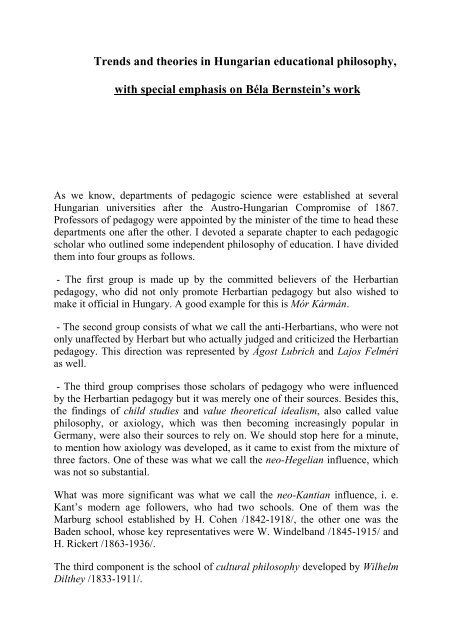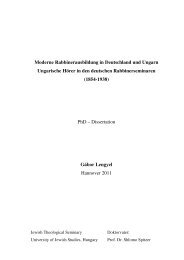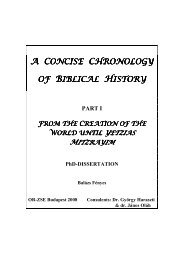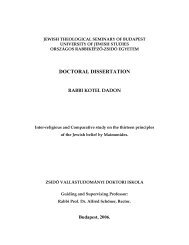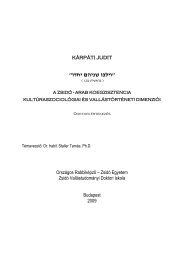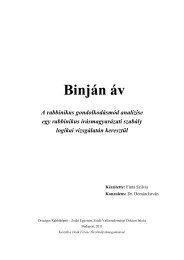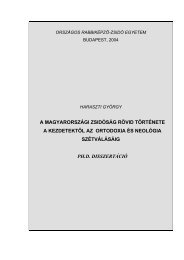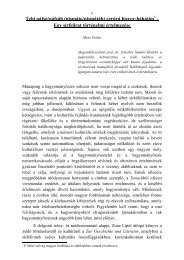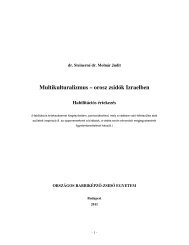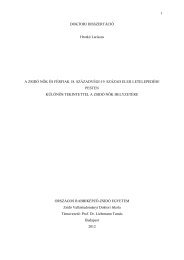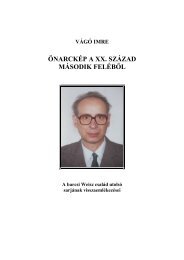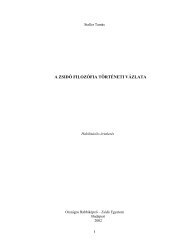Trends and theories in Hungarian educational philosophy ... - Or-Zse
Trends and theories in Hungarian educational philosophy ... - Or-Zse
Trends and theories in Hungarian educational philosophy ... - Or-Zse
You also want an ePaper? Increase the reach of your titles
YUMPU automatically turns print PDFs into web optimized ePapers that Google loves.
<strong>Trends</strong> <strong>and</strong> <strong>theories</strong> <strong>in</strong> <strong>Hungarian</strong> <strong>educational</strong> <strong>philosophy</strong>,<br />
with special emphasis on Béla Bernste<strong>in</strong>’s work<br />
As we know, departments of pedagogic science were established at several<br />
<strong>Hungarian</strong> universities after the Austro-<strong>Hungarian</strong> Compromise of 1867.<br />
Professors of pedagogy were appo<strong>in</strong>ted by the m<strong>in</strong>ister of the time to head these<br />
departments one after the other. I devoted a separate chapter to each pedagogic<br />
scholar who outl<strong>in</strong>ed some <strong>in</strong>dependent <strong>philosophy</strong> of education. I have divided<br />
them <strong>in</strong>to four groups as follows.<br />
- The first group is made up by the committed believers of the Herbartian<br />
pedagogy, who did not only promote Herbartian pedagogy but also wished to<br />
make it official <strong>in</strong> Hungary. A good example for this is Mór Kármán.<br />
- The second group consists of what we call the anti-Herbartians, who were not<br />
only unaffected by Herbart but who actually judged <strong>and</strong> criticized the Herbartian<br />
pedagogy. This direction was represented by Ágost Lubrich <strong>and</strong> Lajos Felméri<br />
as well.<br />
- The third group comprises those scholars of pedagogy who were <strong>in</strong>fluenced<br />
by the Herbartian pedagogy but it was merely one of their sources. Besides this,<br />
the f<strong>in</strong>d<strong>in</strong>gs of child studies <strong>and</strong> value theoretical idealism, also called value<br />
<strong>philosophy</strong>, or axiology, which was then becom<strong>in</strong>g <strong>in</strong>creas<strong>in</strong>gly popular <strong>in</strong><br />
Germany, were also their sources to rely on. We should stop here for a m<strong>in</strong>ute,<br />
to mention how axiology was developed, as it came to exist from the mixture of<br />
three factors. One of these was what we call the neo-Hegelian <strong>in</strong>fluence, which<br />
was not so substantial.<br />
What was more significant was what we call the neo-Kantian <strong>in</strong>fluence, i. e.<br />
Kant’s modern age followers, who had two schools. One of them was the<br />
Marburg school established by H. Cohen /1842-1918/, the other one was the<br />
Baden school, whose key representatives were W. W<strong>in</strong>delb<strong>and</strong> /1845-1915/ <strong>and</strong><br />
H. Rickert /1863-1936/.<br />
The third component is the school of cultural <strong>philosophy</strong> developed by Wilhelm<br />
Dilthey /1833-1911/.
The representatives of the third group, who were already significantly<br />
<strong>in</strong>fluenced by the value theoretical idealism outl<strong>in</strong>ed above, were Ernı F<strong>in</strong>áczy<br />
<strong>and</strong> Ödön Weszely.<br />
- F<strong>in</strong>ally, I have listed those <strong>in</strong> the fourth group who were not affected by the<br />
Herbartian pedagogy, who did not deal with it at all but created someth<strong>in</strong>g new<br />
<strong>and</strong> very unique. Each of these scholars used a different source but neither of<br />
them started out from the Herbartian pedagogy. Good examples for this group<br />
<strong>in</strong>clude Sándor Karácsony, Sándor Imre, Lajos Prohászka, or Béla<br />
Bernste<strong>in</strong>,Ede Neumann <strong>and</strong> Árm<strong>in</strong> Frisch.<br />
All <strong>in</strong> all, the <strong>educational</strong> <strong>philosophy</strong> of the <strong>Hungarian</strong> pedagogic scholars was<br />
strongly def<strong>in</strong>ed by two factors: religion on the one h<strong>and</strong> /<strong>in</strong> the case of Béla<br />
Bernste<strong>in</strong>,Ede Neumann <strong>and</strong> Árm<strong>in</strong> Frisch of course, the Jewish religion/ <strong>and</strong><br />
nation <strong>and</strong> national education on the other h<strong>and</strong>. An exception to this was<br />
Sándor Imre, whose curriculum did not <strong>in</strong>clude religious education, s<strong>in</strong>ce, as he<br />
said, "religion is a private affair". However, national education received all the<br />
more attention <strong>in</strong> his case, s<strong>in</strong>ce he even wrote a book under this title, <strong>in</strong> which<br />
he elaborated a complete concept of national education.<br />
However, the school education practices between the two world wars were not<br />
significantly affected by the above-mentioned pedagogical theoreticians, <strong>in</strong> spite<br />
of the fact that they had a high number of constructive <strong>and</strong> progressive ideas <strong>and</strong><br />
proposals. The reason for all this was that <strong>in</strong> Hungary, the so-called Comenius-<br />
Herbartian model was still <strong>in</strong> use <strong>and</strong> the <strong>educational</strong> m<strong>in</strong>istry did not support<br />
any major modernization of contents or structure. It was especially negative<br />
towards the trends of reform pedagogy, thus these had no impact on state<br />
education at all.<br />
After the Second World War, there was a rupture <strong>and</strong> both factors disappeared<br />
from <strong>Hungarian</strong> pedagogy, to be replaced by socialist ideology. For example,<br />
the place of national education was taken by <strong>in</strong>ternationalism. However, the<br />
Comenius-Herbartian model lived on at schools <strong>and</strong> cont<strong>in</strong>ued to determ<strong>in</strong>e<br />
school education practices. The related <strong>philosophy</strong> <strong>and</strong> ideology, however, were<br />
simply replaced by a leftist one. As a result, a k<strong>in</strong>d of “double education”<br />
developed, which meant that the school <strong>in</strong>termediated totally different values<br />
than those taught by the parents, as the latter were still brought up to believe <strong>in</strong><br />
conservative-Christian values <strong>in</strong> the period between the two World Wars.<br />
F<strong>in</strong>ally, after the political changes of 1989 had come down, value pluralism<br />
appeared, which means an ideological diversity which assumes the co-existence
of different values <strong>and</strong> <strong>in</strong> which the “market”, i.e. the needs of the citizens play a<br />
key role.<br />
Zoltán Bábosik


